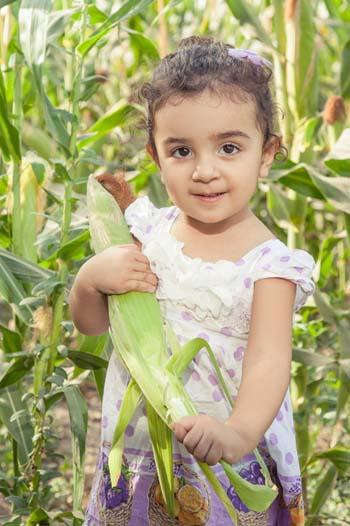Growing sweet corn
Duration/age

A vegetable that is taller than you…
Sweet corn is an easy food to grow and you can grow it in your garden or in a pot.
In September or October choose a place in your garden that is warm and sunny. Dig the soil so that it is ready for planting and water it. Talk with your child about why the plants need good soil and sun to grow.
We need to make sure the roots of the corn can grow deep into the soil.
The seeds need to be planted about 1.5 centimetres deep, or about twice the size of the seed, and in a block formation. If the ground is nice and soft, you can just push the seeds in.
We need to make some holes about 20 centimetres apart. We can use a ruler to measure how far apart they are.
Pick up a seed and put it in the hole. Now gently cover it with more soil and pat it down.
Show your child how to water the plants when the ground is dry.
As the corn grows you can measure the plants. You could make a chart to show how high the corn is growing.
When will the corn plant be taller than you?
After a few weeks see who can find the little cobs growing on the plant. When the silk on the end of the cob is brown they are ready to be picked and eaten. They’ll be ready to eat in about 14 weeks.
Materials you will need
- Spade
- Ruler
- Hose
- Watering can
- Garden bed
Alternative tools
- Pots
Skills this activity improves
Why does this matter?
As your child helps to plant the sweet corn they will be learning about measurement. They will see how small the seeds are, how deep they need to be planted and how far apart. As the plants grow they will be watching how tall they get and how long it takes. These are all different ways that we use measurement with size, distance, height and time.
As your child watches the plant grow and looks for the cobs they will be observing. This is about noticing differences.
What does this lead to?
Lots of practice with measurement will help your child to understand about size, height, time and distance. When they have lots of experience with this they will be able to estimate these kinds of dimensions.
Observation is an important part of learning to read and write. Noticing the difference between letters will help your child to use them more easily. Observation also helps us to see patterns around us and to understand how things work.
Language to use
- Seed, plant
- Shoot, root, leaf
- Sweet corn, vegetable
- Dig, hole, plant
- Grow, tall, taller
- Cob, husk, silk
Questions to use
- Where would be a good, sunny place to plant the sweet corn?
- How long do you think it will take to grow?
- Is it getting taller? How do you know?
Useful tips
- Look for books about growing vegetables at your local library.
- You might also like to take a look at the activities Planting a garden you can eat and Planting a seed.
- Remember to talk to your child in your home language.
More ideas
Your child could draw a picture of the corn every few days to show how it is growing. You could put the date next to each picture.
Variation by age
Three to five year olds
- Cook the sweet corn when it is ready and eat it up.
- If waiting for the sweet corn to grow causes a bit of impatience, you can always buy some from the shop – just so your little one can find out how it tastes.
Questions to ask
- How long is this cob?
- Do you like butter on your sweet corn?
- Do you eat around the cob or along the rows?
Language to use
- Cook, hot, water, boil
- Kernels, rows
- Husk, silk


